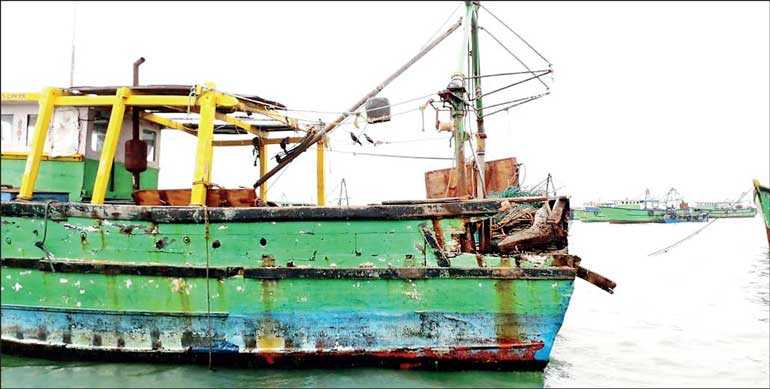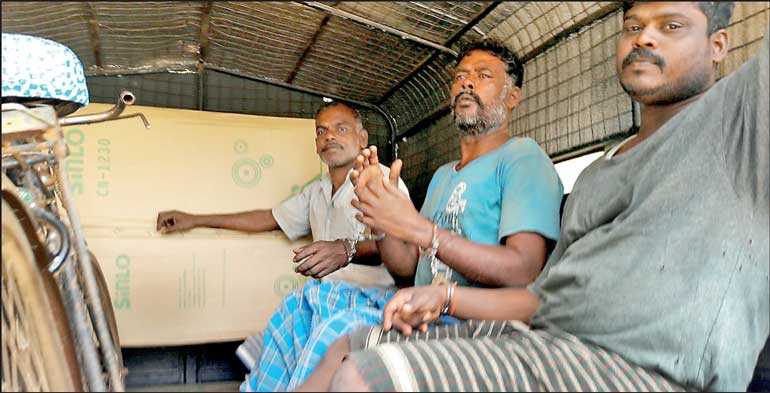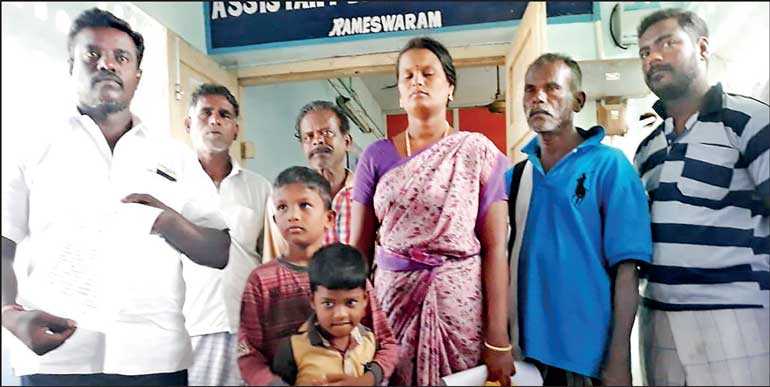Tuesday Mar 18, 2025
Tuesday Mar 18, 2025
Friday, 18 January 2019 00:00 - - {{hitsCtrl.values.hits}}



By S. Ratnajeevan H. Hoole
Newspapers of 16 January report Indian poachers turning on our Navy. An earlier incident of 23 December where poachers really used violence was hardly reported. All this mis- and non-reporting raise questions of the veracity of our Navy and the irresponsibility of our press to us reader. These newspapers have become willing propaganda tools of the Navy, spreading falsehoods that shield the Navy from any culpability. This article reports my best reconstruction of events.
Recall that early in the morning on 13 January (Sunday) in the northern seas a total of 28 Indian fishermen were interdicted on the charge of entering Sri Lankan waters without permission. This has been confirmed by the Navy, admitting that they, the Navy itself, had taken them into custody.
Seventeen fishermen from four boats were arrested in the Delft area and taken to the Kankesanthurai Navy Base, and a further 11 in seas in the proximity of Kilinochchi were interdicted, and taken to the Kiranchi Naval Base. Accordingly, the 11 arrested in Kilinochchi were handed over to the Assistant Commissioner of Fisheries, Kilinochchi and charged. There is no controversy over the Kilinochchi arrests.
Those 17 Indian Fishermen said to have been arrested in Jaffna were attempted to be handed over by the Navy to the Assistant Commissioner of Fisheries, Jaffna. According to information by the Navy, two staff members from the Fisheries Department went to Kankesanthurai. The staff members returned to the Department on the 13th evening after 4 p.m. However, instead of 17, the department had accepted responsibility only for nine Indians who had come in two boats. The remaining eight who had fished in two further boats, say reports, the Department had refused to accept any responsibility for.
At the same time, well after Sunday after 5 p.m., Indian media released a report that a total of 29 fishermen had been captured by Sri Lankan authorities. At this point Jaffna reporters knew that something serious was amiss. When queried both the Fisheries Department and the Navy refused further information.
Some reporters from Jaffna thereupon directly contacted Indian reporters. The latter confirmed that 29 Indians had been captured. Jaffna reporters then obtained 29 names from India and the names of the 28 in Sri Lankan custody. Comparing the two lists, one fisherman named Munnaichaami was seen to be missing from the Sri Lankan Navy’s custody. When it was confirmed that Munnaichaami’s name was missing, Indian sources claimed that Munnaichaami had been murdered by the Sri Lankan Navy. The Indian Consul in Jaffna was now fully alerted and began querying Sri Lankan authorities.
Upon these developments, the Navy issued a statement that a body had been retrieved from the seas, and that it could be that of Munnaichaami. The body was taken to the Kankesanthurai Navy Base.
It is inferred by those who know the system that the Fisheries Department refused to accept the eight fishermen from Kankesanthurai because of the missing ninth person, although they had initially claimed that they had refused because the usual evidence like nets had not been given to them to take to court.
In the circumstance of the Fisheries Department refusing to accept responsibility for body brought to Kankesanthurai and the eight fishermen, the Navy asked the Kankesanthurai Police to assume responsibility. The Police too were reluctant. Following this, the Mallakam Magistrate had his attention drawn to this around 8 p.m. Sunday. The Magistrate ordered the Police to accept the body and report to court. As a result, around 11 p.m. the Jaffna Teaching Hospital accepted the body. The eight fishermen were handed over to the Kankesanthurai Police. All this information was given to the Indian Consul.
The next morning, Monday, the eight fishermen were met independently by reporters and the Indian Consul at the Kankesanthurai Police Station. It is learnt from the testimony of two of the three fishermen who had travelled with the deceased Munnaichaami, namely Kaarmeham (aged 40), and Selvam (aged 45), that the trawler in which they had travelled had been travelled was stopped by Navy boat made of iron (presumably a Dvora), ordered the fishermen (now in custody) to come on board the Navy ship. Seemingly to facilitate that, the Navy boat was brought close to their trawler, at a high speed, and the iron Navy boat smashed the wooden fishing trawler and penetrated its body. The part of the trawler penetrated by the Navy boat entered the pilot’s cabin of the trawler.
During that event, the wooden planks from the trawler crushed the person piloting the trawler. The trawler broke into pieces and capsized. The three jumped into the sea and were picked up by the Navy. However, the pilot Munnaichaami went down with the trawler. Munnaichaami had no chance to jump into the sea or otherwise escape. On account of language difficulties the fishermen could not communicate to the Navy the information on the presence of Munnaichaami in the wreckage. As a result, in a short while, the Navy went to Kankesanthurai with just the three fishermen, leaving Munnaichaami behind.
Likewise, another boat like Munnaichaami’s, a second boat, also has been sunk by the Navy in the vicinity on the same day. The five men who had travelled in the same vessel are with the Navy. In the incident involving the second vessel, two fishermen have been injured – one with serious head injuries that have since been treated by the Navy’s hospital in Kankesanthurai. Of these five, two are young students as learnt from the Kankesanthurai Police Station – one is in Plus 1 Grade in India and the other is in an engineering faculty in India.
On the same day, a third boat also was hit by Sri Lankan Navy’s Dvora and damaged in the rear end of the Indian boat which managed to make it back to India. The damaged trawler is shown with bullet holes as released by Indian sources.
As the story broke at 10 a.m. on the 14th, of the eight fishermen, three who travelled with Munnaichaami, were taken to the Teaching Hospital in a Police vehicle. They were manacled with two handcuffs; that is, the man in the middle had both hands cuffed. The practice is not to handcuff such fishermen when taking them to court. They were being taken to identify Munnaichaami’s body.
Around 11 a.m., these three manacled fishermen identified the body of Munnaichaami who had travelled with them. The three fishermen were then subject to a medical examination at the Teaching Hospital to so that the charge of assault could not be sustained against the Navy. (Those assaulted were the other five who were not brought for a medical examination). These three were then taken back to the Kankesanthurai Police.
The laxity of security, despite the manacles, is seen in the photo where they are seen being taken to Court transporting the Policemen’s personal effects like a bicycle, and their stopping for diesel on the way.
According to normal procedure, cases have been filed against all of them. Following the confirmed identification of the body of Munnaichaami, on the 14th a report was submitted to Court and permission obtained by Police for an autopsy. As a result after 5 p.m. that day, Jaffna Teaching Hospital’s JMO Mayoorathan conducted the autopsy. The next day, 15th, having been a holiday, on the 16th morning, on the basis of Munnaichaami’s daughter asking for his body, the Jaffna Consul for India asked Court for custody of the body. The Mallakam Court has authorised the release.
Why was the Navy careless in coming close to the Indian vessel and ramming it hard enough to sink it? Why did the Navy resort to violence over civil misdemeanours? In answer, it is good to recall a poorly reported incident on 23 December 2018, when the Sri Lankan Navy on small boats (said to be scooter-like) is said to have stopped five Indian fishermen on a fishing boat (presumably in Sri Lanka waters). During that encounter, when the three Navy men tried to bring the Indians ashore, one naval man boarded the Indian boat to be in command of the Indian boat while the other two Navy men were to go in front in their vessels.
However, the Indian trawler took off towards India with the Sri Lankan on board. The Indians had overcome the Navy man. Having given chase, upon reaching Indian waters, the naval man in captivity was dumped overboard. That naval man had a gun on him and fired at the Indian vessel. Three bullet holes are said to visible. The boat reached the Rameshwaran shore and reported to the Indian authorities. As a result their fishing permit has been suspended by Indian authorities and the incident is reported by the Indian press as well as television channels.
When such horrible things were reported only by Indian press and sources, the Sri Lankan Navy higher-ups were questioned by many reporters over three days showing them photographs of the rammed boat with bullet holes. The Navy has denied the occurrence of any such incident.
Therefore people wonder if there is a private mini-war between India and Sri Lanka. Is our Navy hunting Indian fishermen? Is it open season on Indian fishermen because some of them dumped a Navy man in the sea in escaping arrest? Is our press covering up this racist nonsense, making a military campaign out of illegal fishing by poor fishermen? Like the Police shooting at speeding motorists?
Discover Kapruka, the leading online shopping platform in Sri Lanka, where you can conveniently send Gifts and Flowers to your loved ones for any event including Valentine ’s Day. Explore a wide range of popular Shopping Categories on Kapruka, including Toys, Groceries, Electronics, Birthday Cakes, Fruits, Chocolates, Flower Bouquets, Clothing, Watches, Lingerie, Gift Sets and Jewellery. Also if you’re interested in selling with Kapruka, Partner Central by Kapruka is the best solution to start with. Moreover, through Kapruka Global Shop, you can also enjoy the convenience of purchasing products from renowned platforms like Amazon and eBay and have them delivered to Sri Lanka.
Discover Kapruka, the leading online shopping platform in Sri Lanka, where you can conveniently send Gifts and Flowers to your loved ones for any event including Valentine ’s Day. Explore a wide range of popular Shopping Categories on Kapruka, including Toys, Groceries, Electronics, Birthday Cakes, Fruits, Chocolates, Flower Bouquets, Clothing, Watches, Lingerie, Gift Sets and Jewellery. Also if you’re interested in selling with Kapruka, Partner Central by Kapruka is the best solution to start with. Moreover, through Kapruka Global Shop, you can also enjoy the convenience of purchasing products from renowned platforms like Amazon and eBay and have them delivered to Sri Lanka.